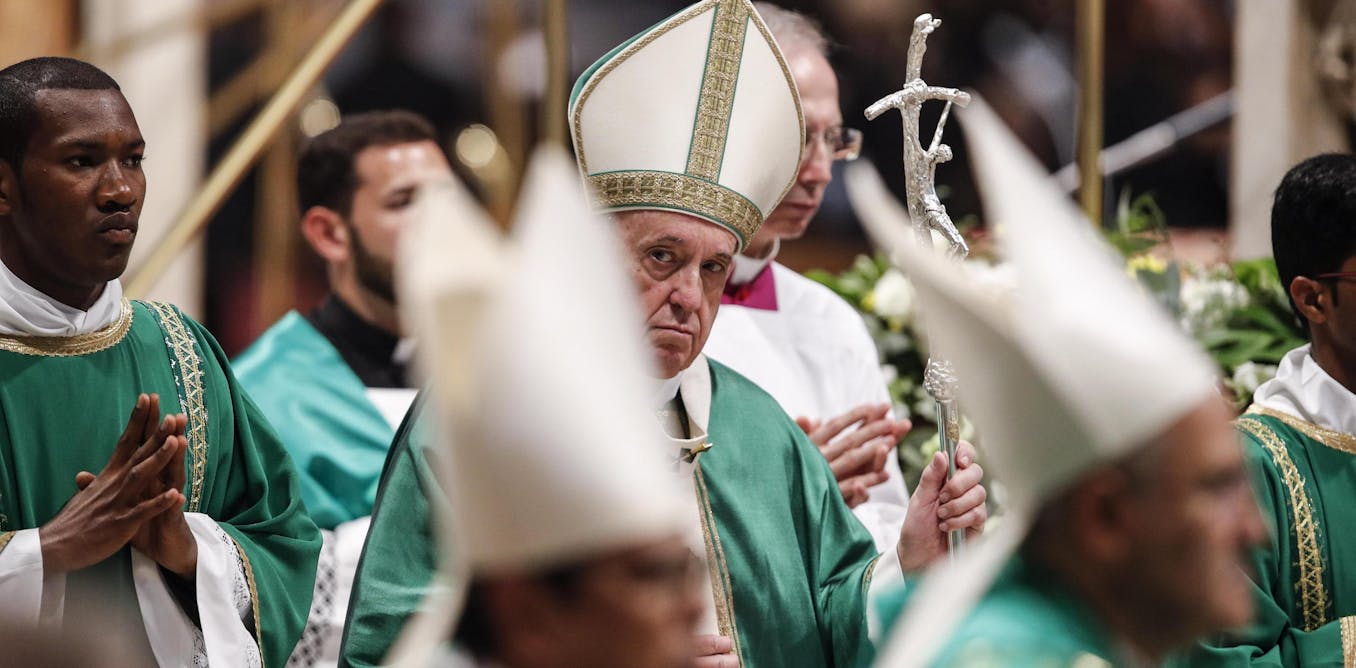[ad_1]
For nearly a thousand years, Roman Catholic priests have been required to be celibate. But this age-old practice is now under fire, with the suggestion that the rules should be relaxed for the Latin American Catholic Church.
In response to such rumblings, a new book sets out a vigorous defense of priestly celibacy against the “fashion errors” of its detractors. The book is particularly noteworthy: it is co-authored by Cardinal Robert Sarah and former Pope, Benedict XVI, who since his resignation in 2013 has avoided public intervention during the time of his successor, Pope Francis (l Archbishop Georg Gänswein, secretary to Benedict, has since requested that Benedict’s name and signature be removed from the book).
The publication of the book is proof of the divisions that exist within the church. The relationship between the two popes is already highly publicized after the publication of a fictionalized biography about them. The publication of the book coincides with an expected response from Pope Francis to the recommendations made at the synod – church council – held in the Amazon region in October 2019.
Within Protestant congregations and the Eastern Orthodox Church, the ordination of married men has long been accepted. But for most of a millennium celibacy was required of priests in the Roman Catholic tradition. Any decision to ordain married men to the priesthood would be a very visible and controversial departure from the disciplines and traditions of the Church.
The Amazon synod opened the door to high-profile discussions about the place of celibacy in the modern Roman Catholic priesthood. For the first time, an open statement was made in favor of the ordination of the bride and groom “viri probati(Men of proven virtue) as priests. Although Pope Francis has yet to accept the Synod’s recommendations, he has expressed sympathy for the problems facing the church in the Amazon.
So far, the ordination of married men has been touted as a solution to a severe shortage of priests in the Amazon region. The synod recognized the value of celibacy as a “gift from God†but suggested that the pressures facing the church in the Amazon justified “legitimate diversity†in practice.
But any precedent set in the Amazon will raise further questions about the future of compulsory celibacy for Roman Catholic clergy in other parts of the world. The final document made it clear that many synod participants were in favor of expanding the scope of its recommendations to the rest of the Roman Catholic Church.
Wideweb / Shutterstock.com
Celibacy for a millennium
The universal requirement of celibacy was forcefully imposed on the clergy in 1123 and again in 1139. But these decrees reflected a much longer tradition in the Church in which the self-imposed discipline of asceticism – including continence sexuality, poverty and abstinence – has become the defining characteristics of piety and priesthood.
This view was first challenged in the 16th century with the rise of Protestantism. The Protestant Church’s markedly different view of the priesthood – and rejection of priestly celibacy – allowed both the ordination of married men and the marriage of those already in sacred orders.
Whatever their views on the rest of Protestant theology, those priests who chose to take wives were making a visible statement against the discipline of the Catholic Church. This statement has not always been welcomed by more conservative congregations, for whom a married priest was an unwelcome symbol of religious change. The legalization of clerical marriage in England in 1549 did little to protect female clergy from being denounced in the streets as whores and concubines. Martin Luther, the founding father of the German Reformation, wrote that his very satirical marriage to a former nun “made angels laugh and demons weep.”
The reaffirmation of compulsory clerical celibacy in the Catholic Church at the Council of Trent (1543-1563) established the issue as a permanent marker of divisions within Christendom. These decrees still have symbolic value in the context of modern debates. Isabelle de Gaulmyn, editor-in-chief of La Croix, argued that the recommendation of the Amazon Synod’s declaration on celibacy marks the “end†of the Roman Catholic Church as defined at the Council of Trent.

jimforest / flickr, CC BY-NC-ND
And then ?
But if the synod’s recommendations are accepted, it wouldn’t be the first time that a local exception has been made to the discipline of celibacy in the Roman Catholic Church.
Married priests who left the Church of England after its decision to ordain women in 1994, for example, were allowed to be ordained Catholic priests without committing to celibacy. In 2014, the former Anglican clergy represented up to one in ten English Catholic priests, and in the United States, more than 100 married former episcopal clergy have been ordained into the Catholic Church.
Such precedents highlight the importance of the distinction between the marriage of priests and the ordination of married men to the priesthood. It is important to note that, as in these cases, the synod’s recommendations on the ordination of “viri probati“Do not make celibacy voluntary for the rest of the ordained clergy. Instead, the recommendation is presented as a direct response to the needs of the Amazon region and the shortage of priests to serve its communities.
But a few days before the opening of the Amazon synod, Canadian Cardinal Marc Ouellet, president of the Pontifical Commission for Latin America, argued that married priests cannot be seen as a quick solution to pastoral problems in Latin America. and beyond. The publication of this new book – and the fury surrounding it – is a warning that the watering down of celibacy requirements for priests is not universally accepted as a positive response to the needs of the church.
Correction: This article was modified on January 28 to clarify that Archbishop Georg Gänswein, Secretary to Pope Emeritus Benedict XVI, requested the deletion of Benedict’s name from the book From the Depths of Our Heart, and not Benedict himself.
[ad_2]

